Nurses' Role: ACS Code of Conduct
VerifiedAdded on 2019/10/30
|8
|1879
|222
Essay
AI Summary
This essay analyzes a case study involving a registered nurse, Ms. Conyard, who was found guilty of providing unsatisfactory professional conduct. The essay details Ms. Conyard's failure to adequately respond to a deteriorating patient's condition, violating several points of the Australian Code of Conduct for Nurses and the NMBA's professional standards. The essay highlights Ms. Conyard's negligence in not contacting the on-call doctor or the patient's physician despite the patient's critical condition, ultimately leading to the patient's death. The essay concludes by emphasizing the importance of adhering to professional codes of conduct, prioritizing patient well-being, and maintaining accurate documentation in nursing practice. The case study serves as a learning tool for nurses to understand their responsibilities and the potential consequences of professional misconduct.
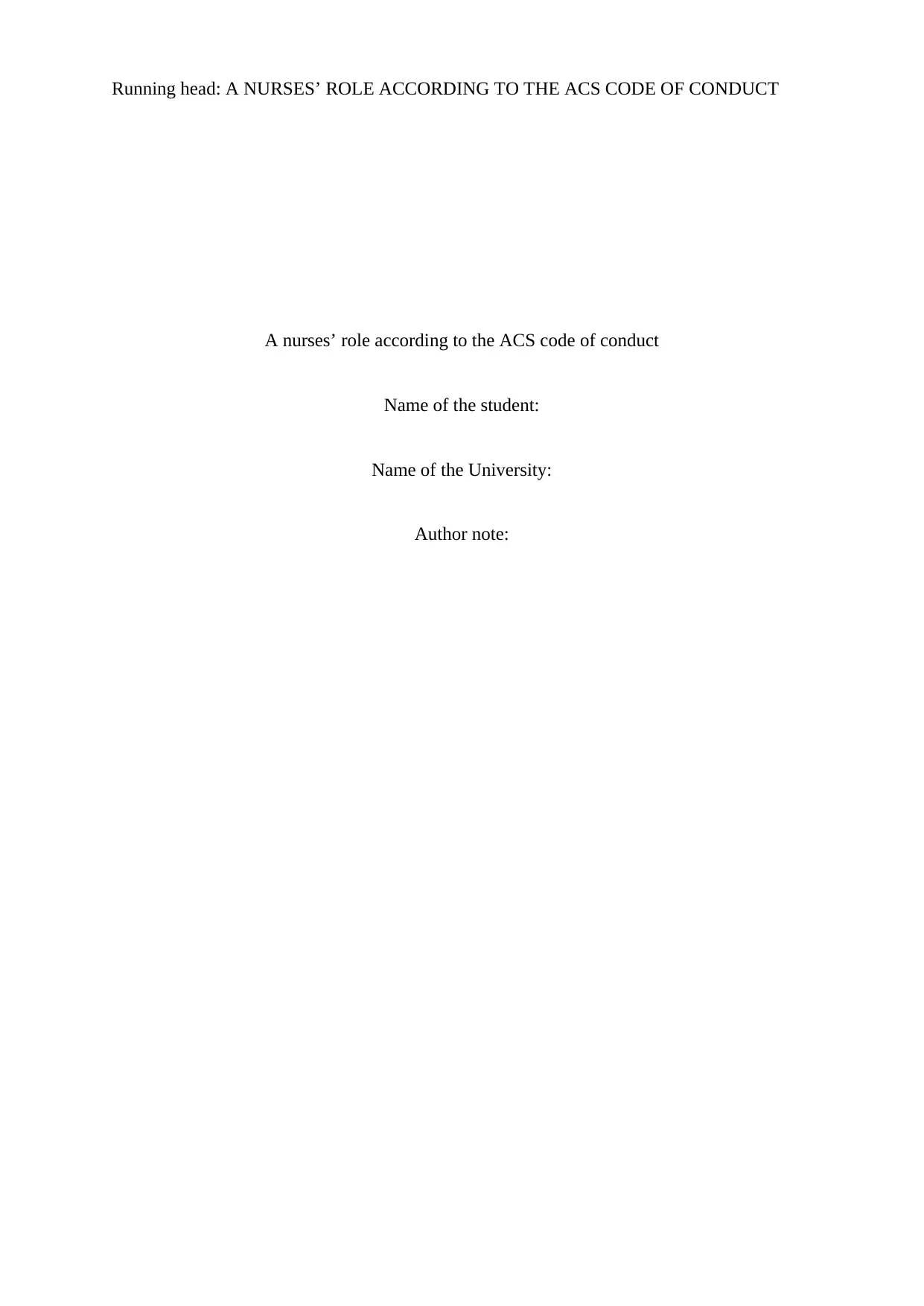
Running head: A NURSES’ ROLE ACCORDING TO THE ACS CODE OF CONDUCT
A nurses’ role according to the ACS code of conduct
Name of the student:
Name of the University:
Author note:
A nurses’ role according to the ACS code of conduct
Name of the student:
Name of the University:
Author note:
Paraphrase This Document
Need a fresh take? Get an instant paraphrase of this document with our AI Paraphraser
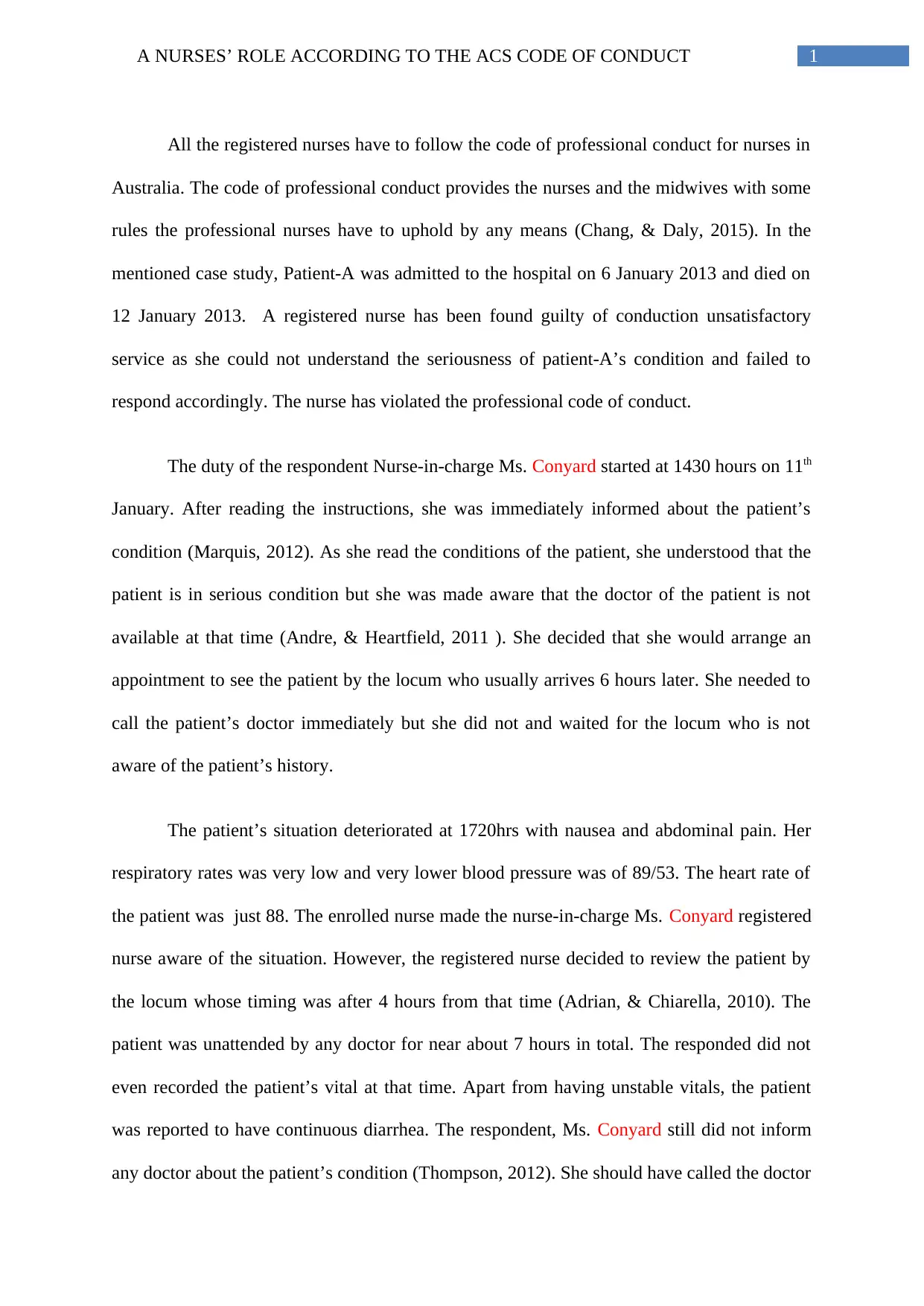
1A NURSES’ ROLE ACCORDING TO THE ACS CODE OF CONDUCT
All the registered nurses have to follow the code of professional conduct for nurses in
Australia. The code of professional conduct provides the nurses and the midwives with some
rules the professional nurses have to uphold by any means (Chang, & Daly, 2015). In the
mentioned case study, Patient-A was admitted to the hospital on 6 January 2013 and died on
12 January 2013. A registered nurse has been found guilty of conduction unsatisfactory
service as she could not understand the seriousness of patient-A’s condition and failed to
respond accordingly. The nurse has violated the professional code of conduct.
The duty of the respondent Nurse-in-charge Ms. Conyard started at 1430 hours on 11th
January. After reading the instructions, she was immediately informed about the patient’s
condition (Marquis, 2012). As she read the conditions of the patient, she understood that the
patient is in serious condition but she was made aware that the doctor of the patient is not
available at that time (Andre, & Heartfield, 2011 ). She decided that she would arrange an
appointment to see the patient by the locum who usually arrives 6 hours later. She needed to
call the patient’s doctor immediately but she did not and waited for the locum who is not
aware of the patient’s history.
The patient’s situation deteriorated at 1720hrs with nausea and abdominal pain. Her
respiratory rates was very low and very lower blood pressure was of 89/53. The heart rate of
the patient was just 88. The enrolled nurse made the nurse-in-charge Ms. Conyard registered
nurse aware of the situation. However, the registered nurse decided to review the patient by
the locum whose timing was after 4 hours from that time (Adrian, & Chiarella, 2010). The
patient was unattended by any doctor for near about 7 hours in total. The responded did not
even recorded the patient’s vital at that time. Apart from having unstable vitals, the patient
was reported to have continuous diarrhea. The respondent, Ms. Conyard still did not inform
any doctor about the patient’s condition (Thompson, 2012). She should have called the doctor
All the registered nurses have to follow the code of professional conduct for nurses in
Australia. The code of professional conduct provides the nurses and the midwives with some
rules the professional nurses have to uphold by any means (Chang, & Daly, 2015). In the
mentioned case study, Patient-A was admitted to the hospital on 6 January 2013 and died on
12 January 2013. A registered nurse has been found guilty of conduction unsatisfactory
service as she could not understand the seriousness of patient-A’s condition and failed to
respond accordingly. The nurse has violated the professional code of conduct.
The duty of the respondent Nurse-in-charge Ms. Conyard started at 1430 hours on 11th
January. After reading the instructions, she was immediately informed about the patient’s
condition (Marquis, 2012). As she read the conditions of the patient, she understood that the
patient is in serious condition but she was made aware that the doctor of the patient is not
available at that time (Andre, & Heartfield, 2011 ). She decided that she would arrange an
appointment to see the patient by the locum who usually arrives 6 hours later. She needed to
call the patient’s doctor immediately but she did not and waited for the locum who is not
aware of the patient’s history.
The patient’s situation deteriorated at 1720hrs with nausea and abdominal pain. Her
respiratory rates was very low and very lower blood pressure was of 89/53. The heart rate of
the patient was just 88. The enrolled nurse made the nurse-in-charge Ms. Conyard registered
nurse aware of the situation. However, the registered nurse decided to review the patient by
the locum whose timing was after 4 hours from that time (Adrian, & Chiarella, 2010). The
patient was unattended by any doctor for near about 7 hours in total. The responded did not
even recorded the patient’s vital at that time. Apart from having unstable vitals, the patient
was reported to have continuous diarrhea. The respondent, Ms. Conyard still did not inform
any doctor about the patient’s condition (Thompson, 2012). She should have called the doctor
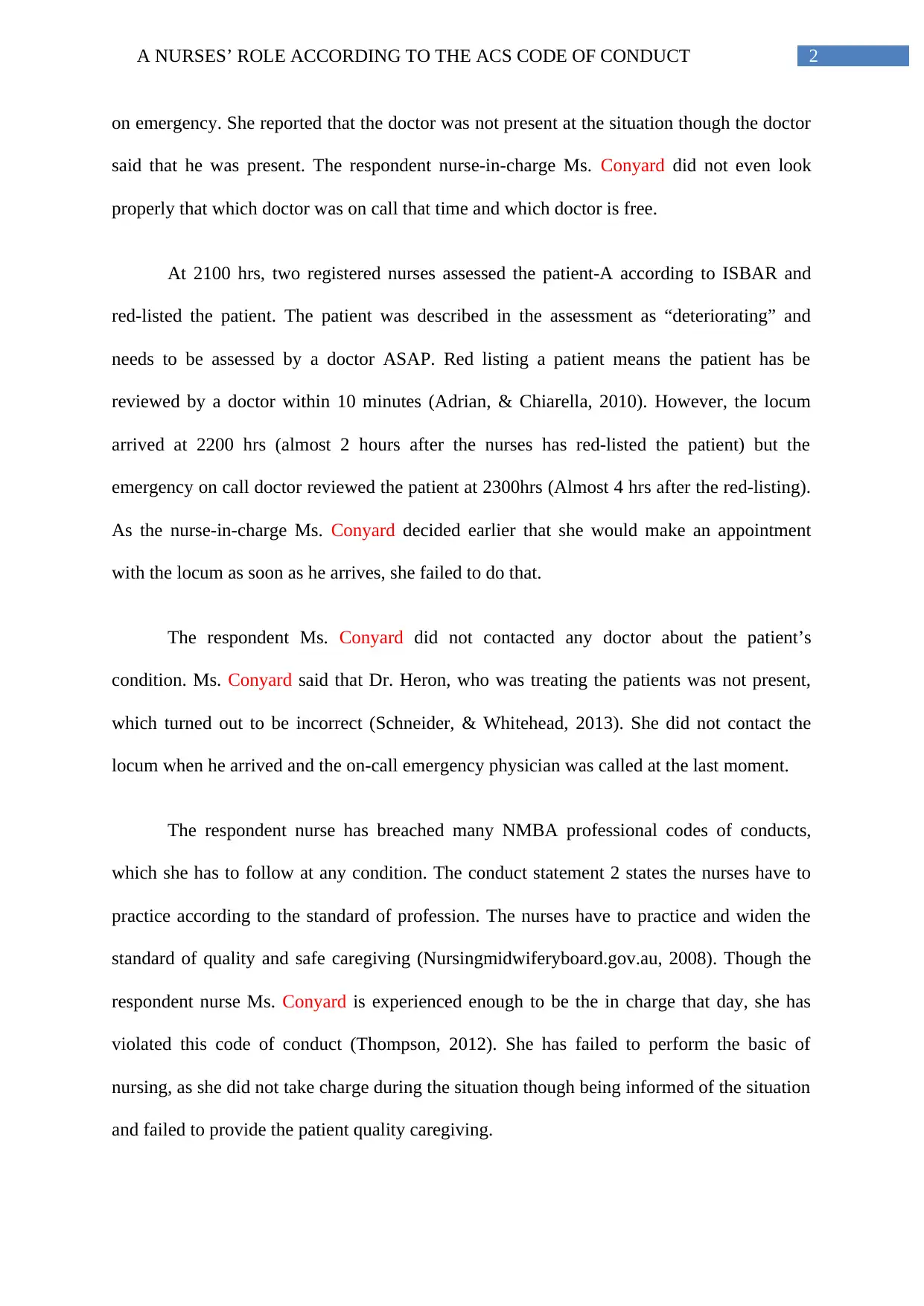
2A NURSES’ ROLE ACCORDING TO THE ACS CODE OF CONDUCT
on emergency. She reported that the doctor was not present at the situation though the doctor
said that he was present. The respondent nurse-in-charge Ms. Conyard did not even look
properly that which doctor was on call that time and which doctor is free.
At 2100 hrs, two registered nurses assessed the patient-A according to ISBAR and
red-listed the patient. The patient was described in the assessment as “deteriorating” and
needs to be assessed by a doctor ASAP. Red listing a patient means the patient has be
reviewed by a doctor within 10 minutes (Adrian, & Chiarella, 2010). However, the locum
arrived at 2200 hrs (almost 2 hours after the nurses has red-listed the patient) but the
emergency on call doctor reviewed the patient at 2300hrs (Almost 4 hrs after the red-listing).
As the nurse-in-charge Ms. Conyard decided earlier that she would make an appointment
with the locum as soon as he arrives, she failed to do that.
The respondent Ms. Conyard did not contacted any doctor about the patient’s
condition. Ms. Conyard said that Dr. Heron, who was treating the patients was not present,
which turned out to be incorrect (Schneider, & Whitehead, 2013). She did not contact the
locum when he arrived and the on-call emergency physician was called at the last moment.
The respondent nurse has breached many NMBA professional codes of conducts,
which she has to follow at any condition. The conduct statement 2 states the nurses have to
practice according to the standard of profession. The nurses have to practice and widen the
standard of quality and safe caregiving (Nursingmidwiferyboard.gov.au, 2008). Though the
respondent nurse Ms. Conyard is experienced enough to be the in charge that day, she has
violated this code of conduct (Thompson, 2012). She has failed to perform the basic of
nursing, as she did not take charge during the situation though being informed of the situation
and failed to provide the patient quality caregiving.
on emergency. She reported that the doctor was not present at the situation though the doctor
said that he was present. The respondent nurse-in-charge Ms. Conyard did not even look
properly that which doctor was on call that time and which doctor is free.
At 2100 hrs, two registered nurses assessed the patient-A according to ISBAR and
red-listed the patient. The patient was described in the assessment as “deteriorating” and
needs to be assessed by a doctor ASAP. Red listing a patient means the patient has be
reviewed by a doctor within 10 minutes (Adrian, & Chiarella, 2010). However, the locum
arrived at 2200 hrs (almost 2 hours after the nurses has red-listed the patient) but the
emergency on call doctor reviewed the patient at 2300hrs (Almost 4 hrs after the red-listing).
As the nurse-in-charge Ms. Conyard decided earlier that she would make an appointment
with the locum as soon as he arrives, she failed to do that.
The respondent Ms. Conyard did not contacted any doctor about the patient’s
condition. Ms. Conyard said that Dr. Heron, who was treating the patients was not present,
which turned out to be incorrect (Schneider, & Whitehead, 2013). She did not contact the
locum when he arrived and the on-call emergency physician was called at the last moment.
The respondent nurse has breached many NMBA professional codes of conducts,
which she has to follow at any condition. The conduct statement 2 states the nurses have to
practice according to the standard of profession. The nurses have to practice and widen the
standard of quality and safe caregiving (Nursingmidwiferyboard.gov.au, 2008). Though the
respondent nurse Ms. Conyard is experienced enough to be the in charge that day, she has
violated this code of conduct (Thompson, 2012). She has failed to perform the basic of
nursing, as she did not take charge during the situation though being informed of the situation
and failed to provide the patient quality caregiving.
⊘ This is a preview!⊘
Do you want full access?
Subscribe today to unlock all pages.

Trusted by 1+ million students worldwide
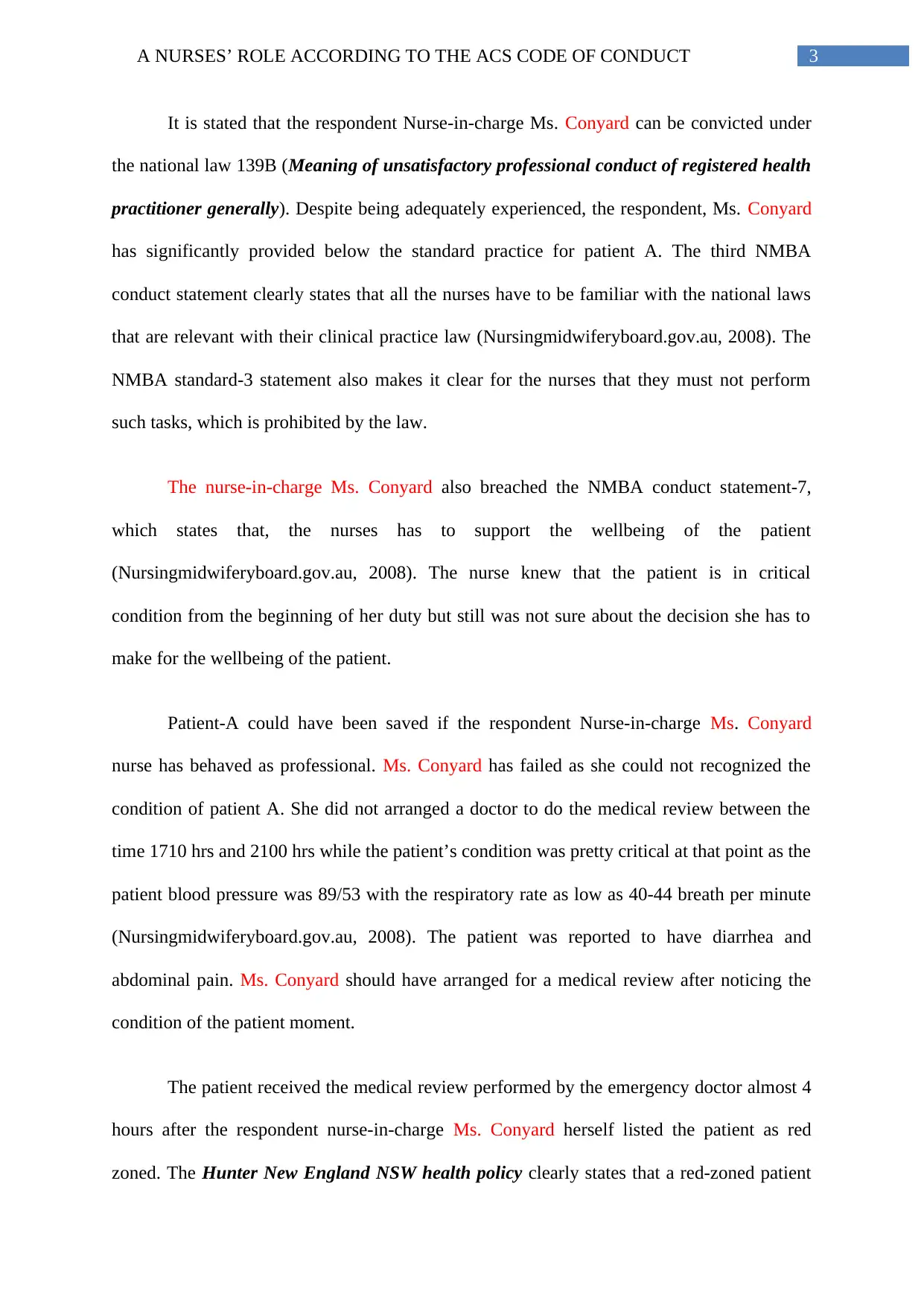
3A NURSES’ ROLE ACCORDING TO THE ACS CODE OF CONDUCT
It is stated that the respondent Nurse-in-charge Ms. Conyard can be convicted under
the national law 139B (Meaning of unsatisfactory professional conduct of registered health
practitioner generally). Despite being adequately experienced, the respondent, Ms. Conyard
has significantly provided below the standard practice for patient A. The third NMBA
conduct statement clearly states that all the nurses have to be familiar with the national laws
that are relevant with their clinical practice law (Nursingmidwiferyboard.gov.au, 2008). The
NMBA standard-3 statement also makes it clear for the nurses that they must not perform
such tasks, which is prohibited by the law.
The nurse-in-charge Ms. Conyard also breached the NMBA conduct statement-7,
which states that, the nurses has to support the wellbeing of the patient
(Nursingmidwiferyboard.gov.au, 2008). The nurse knew that the patient is in critical
condition from the beginning of her duty but still was not sure about the decision she has to
make for the wellbeing of the patient.
Patient-A could have been saved if the respondent Nurse-in-charge Ms. Conyard
nurse has behaved as professional. Ms. Conyard has failed as she could not recognized the
condition of patient A. She did not arranged a doctor to do the medical review between the
time 1710 hrs and 2100 hrs while the patient’s condition was pretty critical at that point as the
patient blood pressure was 89/53 with the respiratory rate as low as 40-44 breath per minute
(Nursingmidwiferyboard.gov.au, 2008). The patient was reported to have diarrhea and
abdominal pain. Ms. Conyard should have arranged for a medical review after noticing the
condition of the patient moment.
The patient received the medical review performed by the emergency doctor almost 4
hours after the respondent nurse-in-charge Ms. Conyard herself listed the patient as red
zoned. The Hunter New England NSW health policy clearly states that a red-zoned patient
It is stated that the respondent Nurse-in-charge Ms. Conyard can be convicted under
the national law 139B (Meaning of unsatisfactory professional conduct of registered health
practitioner generally). Despite being adequately experienced, the respondent, Ms. Conyard
has significantly provided below the standard practice for patient A. The third NMBA
conduct statement clearly states that all the nurses have to be familiar with the national laws
that are relevant with their clinical practice law (Nursingmidwiferyboard.gov.au, 2008). The
NMBA standard-3 statement also makes it clear for the nurses that they must not perform
such tasks, which is prohibited by the law.
The nurse-in-charge Ms. Conyard also breached the NMBA conduct statement-7,
which states that, the nurses has to support the wellbeing of the patient
(Nursingmidwiferyboard.gov.au, 2008). The nurse knew that the patient is in critical
condition from the beginning of her duty but still was not sure about the decision she has to
make for the wellbeing of the patient.
Patient-A could have been saved if the respondent Nurse-in-charge Ms. Conyard
nurse has behaved as professional. Ms. Conyard has failed as she could not recognized the
condition of patient A. She did not arranged a doctor to do the medical review between the
time 1710 hrs and 2100 hrs while the patient’s condition was pretty critical at that point as the
patient blood pressure was 89/53 with the respiratory rate as low as 40-44 breath per minute
(Nursingmidwiferyboard.gov.au, 2008). The patient was reported to have diarrhea and
abdominal pain. Ms. Conyard should have arranged for a medical review after noticing the
condition of the patient moment.
The patient received the medical review performed by the emergency doctor almost 4
hours after the respondent nurse-in-charge Ms. Conyard herself listed the patient as red
zoned. The Hunter New England NSW health policy clearly states that a red-zoned patient
Paraphrase This Document
Need a fresh take? Get an instant paraphrase of this document with our AI Paraphraser
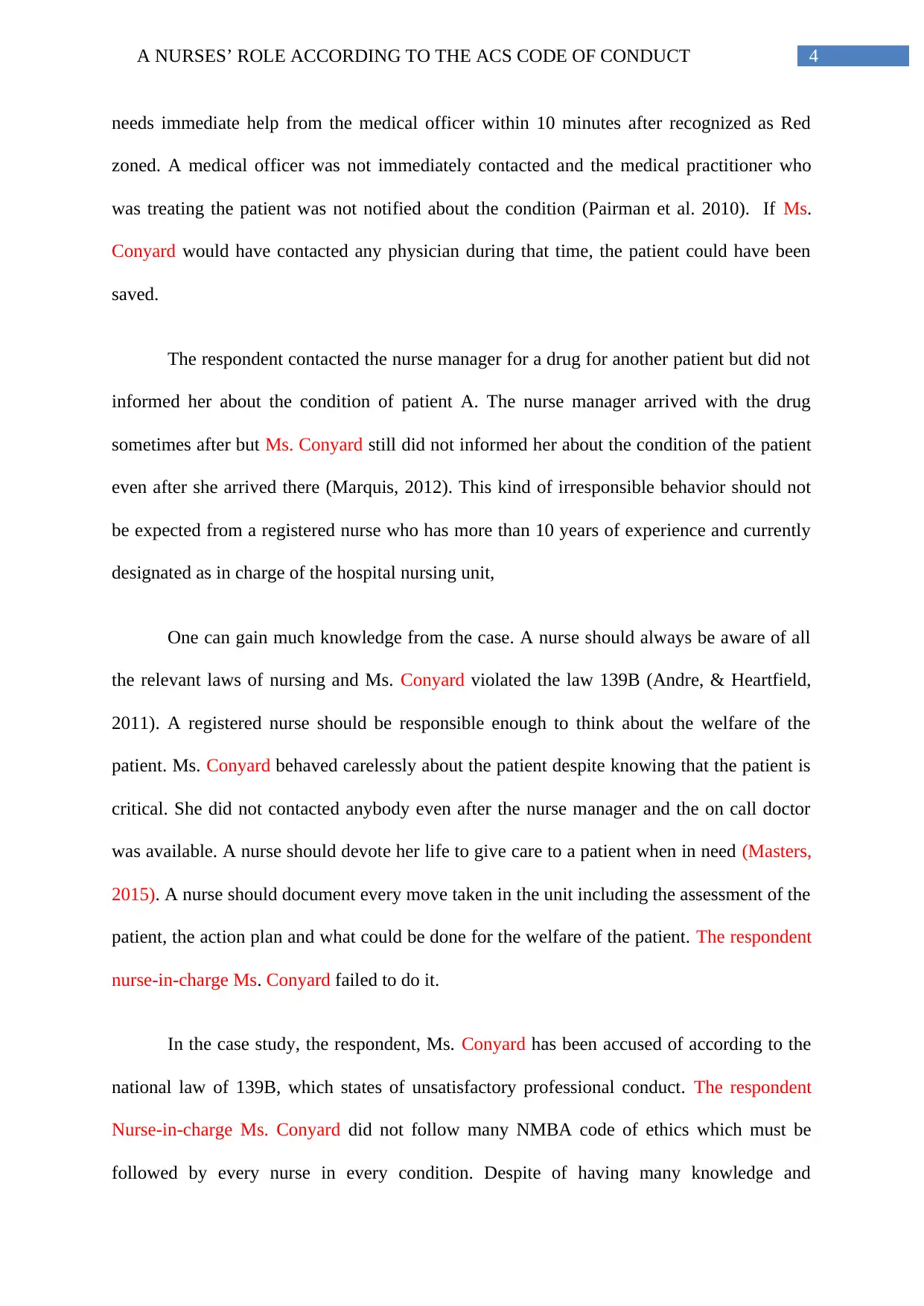
4A NURSES’ ROLE ACCORDING TO THE ACS CODE OF CONDUCT
needs immediate help from the medical officer within 10 minutes after recognized as Red
zoned. A medical officer was not immediately contacted and the medical practitioner who
was treating the patient was not notified about the condition (Pairman et al. 2010). If Ms.
Conyard would have contacted any physician during that time, the patient could have been
saved.
The respondent contacted the nurse manager for a drug for another patient but did not
informed her about the condition of patient A. The nurse manager arrived with the drug
sometimes after but Ms. Conyard still did not informed her about the condition of the patient
even after she arrived there (Marquis, 2012). This kind of irresponsible behavior should not
be expected from a registered nurse who has more than 10 years of experience and currently
designated as in charge of the hospital nursing unit,
One can gain much knowledge from the case. A nurse should always be aware of all
the relevant laws of nursing and Ms. Conyard violated the law 139B (Andre, & Heartfield,
2011). A registered nurse should be responsible enough to think about the welfare of the
patient. Ms. Conyard behaved carelessly about the patient despite knowing that the patient is
critical. She did not contacted anybody even after the nurse manager and the on call doctor
was available. A nurse should devote her life to give care to a patient when in need (Masters,
2015). A nurse should document every move taken in the unit including the assessment of the
patient, the action plan and what could be done for the welfare of the patient. The respondent
nurse-in-charge Ms. Conyard failed to do it.
In the case study, the respondent, Ms. Conyard has been accused of according to the
national law of 139B, which states of unsatisfactory professional conduct. The respondent
Nurse-in-charge Ms. Conyard did not follow many NMBA code of ethics which must be
followed by every nurse in every condition. Despite of having many knowledge and
needs immediate help from the medical officer within 10 minutes after recognized as Red
zoned. A medical officer was not immediately contacted and the medical practitioner who
was treating the patient was not notified about the condition (Pairman et al. 2010). If Ms.
Conyard would have contacted any physician during that time, the patient could have been
saved.
The respondent contacted the nurse manager for a drug for another patient but did not
informed her about the condition of patient A. The nurse manager arrived with the drug
sometimes after but Ms. Conyard still did not informed her about the condition of the patient
even after she arrived there (Marquis, 2012). This kind of irresponsible behavior should not
be expected from a registered nurse who has more than 10 years of experience and currently
designated as in charge of the hospital nursing unit,
One can gain much knowledge from the case. A nurse should always be aware of all
the relevant laws of nursing and Ms. Conyard violated the law 139B (Andre, & Heartfield,
2011). A registered nurse should be responsible enough to think about the welfare of the
patient. Ms. Conyard behaved carelessly about the patient despite knowing that the patient is
critical. She did not contacted anybody even after the nurse manager and the on call doctor
was available. A nurse should devote her life to give care to a patient when in need (Masters,
2015). A nurse should document every move taken in the unit including the assessment of the
patient, the action plan and what could be done for the welfare of the patient. The respondent
nurse-in-charge Ms. Conyard failed to do it.
In the case study, the respondent, Ms. Conyard has been accused of according to the
national law of 139B, which states of unsatisfactory professional conduct. The respondent
Nurse-in-charge Ms. Conyard did not follow many NMBA code of ethics which must be
followed by every nurse in every condition. Despite of having many knowledge and
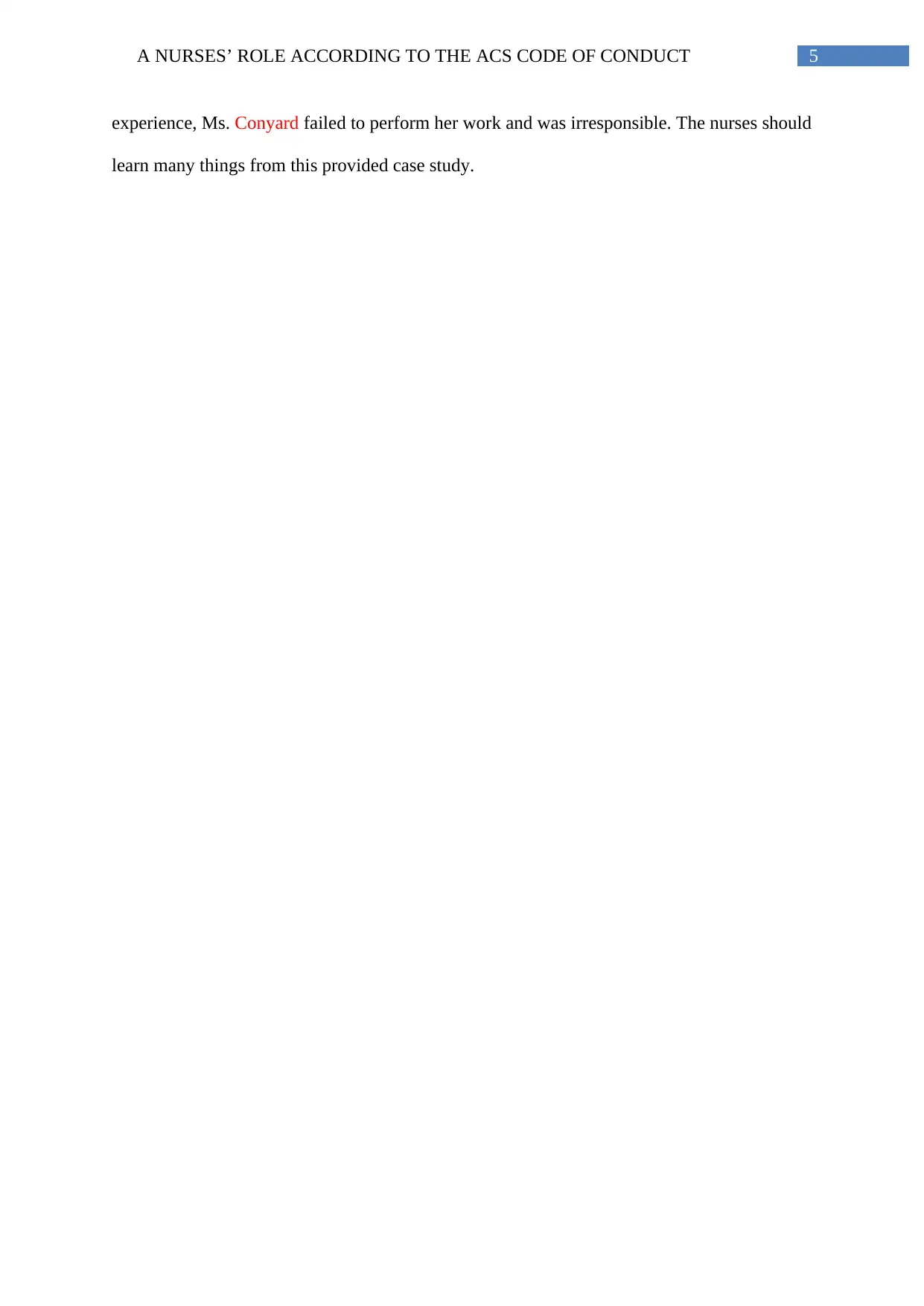
5A NURSES’ ROLE ACCORDING TO THE ACS CODE OF CONDUCT
experience, Ms. Conyard failed to perform her work and was irresponsible. The nurses should
learn many things from this provided case study.
experience, Ms. Conyard failed to perform her work and was irresponsible. The nurses should
learn many things from this provided case study.
⊘ This is a preview!⊘
Do you want full access?
Subscribe today to unlock all pages.

Trusted by 1+ million students worldwide
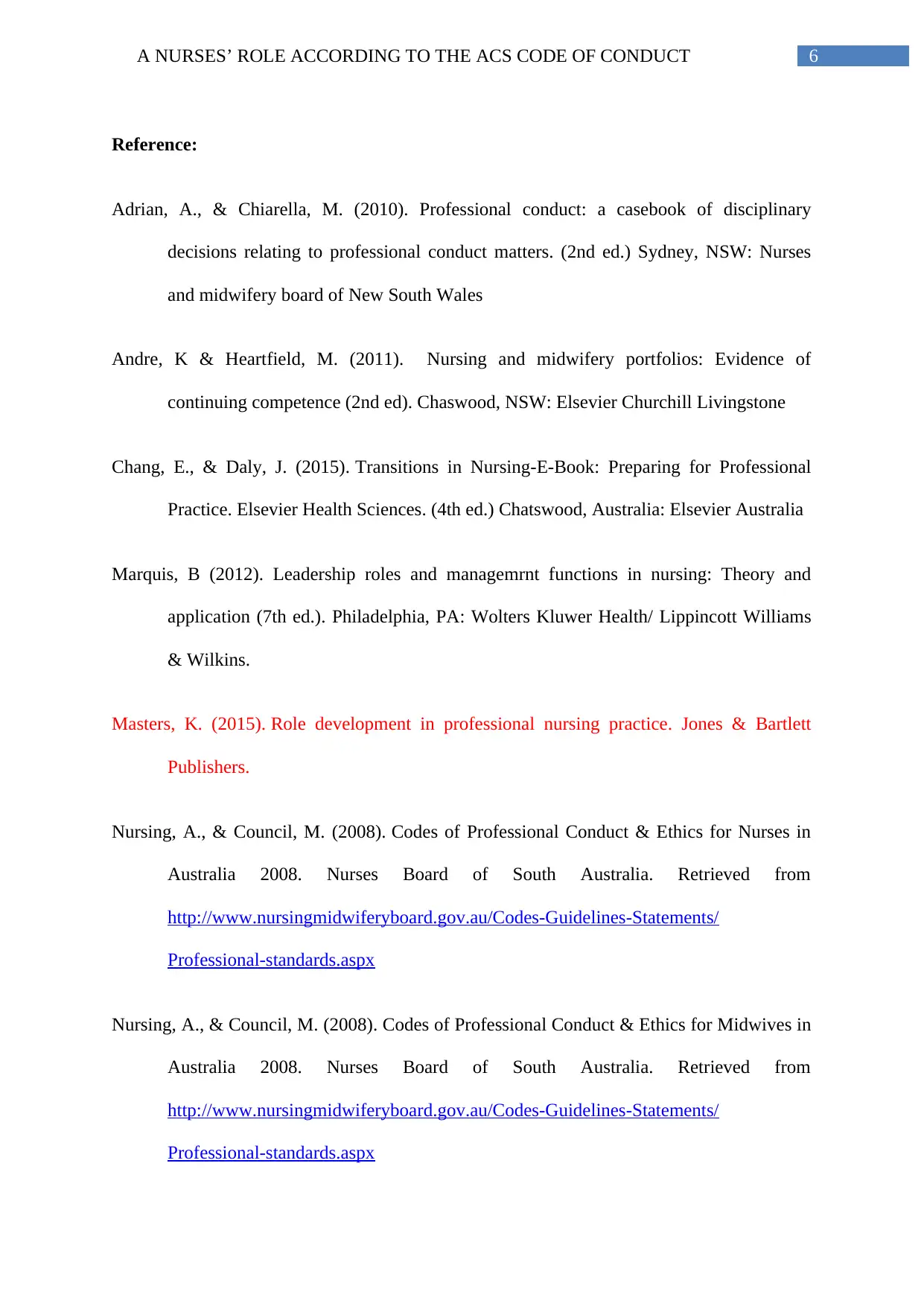
6A NURSES’ ROLE ACCORDING TO THE ACS CODE OF CONDUCT
Reference:
Adrian, A., & Chiarella, M. (2010). Professional conduct: a casebook of disciplinary
decisions relating to professional conduct matters. (2nd ed.) Sydney, NSW: Nurses
and midwifery board of New South Wales
Andre, K & Heartfield, M. (2011). Nursing and midwifery portfolios: Evidence of
continuing competence (2nd ed). Chaswood, NSW: Elsevier Churchill Livingstone
Chang, E., & Daly, J. (2015). Transitions in Nursing-E-Book: Preparing for Professional
Practice. Elsevier Health Sciences. (4th ed.) Chatswood, Australia: Elsevier Australia
Marquis, B (2012). Leadership roles and managemrnt functions in nursing: Theory and
application (7th ed.). Philadelphia, PA: Wolters Kluwer Health/ Lippincott Williams
& Wilkins.
Masters, K. (2015). Role development in professional nursing practice. Jones & Bartlett
Publishers.
Nursing, A., & Council, M. (2008). Codes of Professional Conduct & Ethics for Nurses in
Australia 2008. Nurses Board of South Australia. Retrieved from
http://www.nursingmidwiferyboard.gov.au/Codes-Guidelines-Statements/
Professional-standards.aspx
Nursing, A., & Council, M. (2008). Codes of Professional Conduct & Ethics for Midwives in
Australia 2008. Nurses Board of South Australia. Retrieved from
http://www.nursingmidwiferyboard.gov.au/Codes-Guidelines-Statements/
Professional-standards.aspx
Reference:
Adrian, A., & Chiarella, M. (2010). Professional conduct: a casebook of disciplinary
decisions relating to professional conduct matters. (2nd ed.) Sydney, NSW: Nurses
and midwifery board of New South Wales
Andre, K & Heartfield, M. (2011). Nursing and midwifery portfolios: Evidence of
continuing competence (2nd ed). Chaswood, NSW: Elsevier Churchill Livingstone
Chang, E., & Daly, J. (2015). Transitions in Nursing-E-Book: Preparing for Professional
Practice. Elsevier Health Sciences. (4th ed.) Chatswood, Australia: Elsevier Australia
Marquis, B (2012). Leadership roles and managemrnt functions in nursing: Theory and
application (7th ed.). Philadelphia, PA: Wolters Kluwer Health/ Lippincott Williams
& Wilkins.
Masters, K. (2015). Role development in professional nursing practice. Jones & Bartlett
Publishers.
Nursing, A., & Council, M. (2008). Codes of Professional Conduct & Ethics for Nurses in
Australia 2008. Nurses Board of South Australia. Retrieved from
http://www.nursingmidwiferyboard.gov.au/Codes-Guidelines-Statements/
Professional-standards.aspx
Nursing, A., & Council, M. (2008). Codes of Professional Conduct & Ethics for Midwives in
Australia 2008. Nurses Board of South Australia. Retrieved from
http://www.nursingmidwiferyboard.gov.au/Codes-Guidelines-Statements/
Professional-standards.aspx
Paraphrase This Document
Need a fresh take? Get an instant paraphrase of this document with our AI Paraphraser
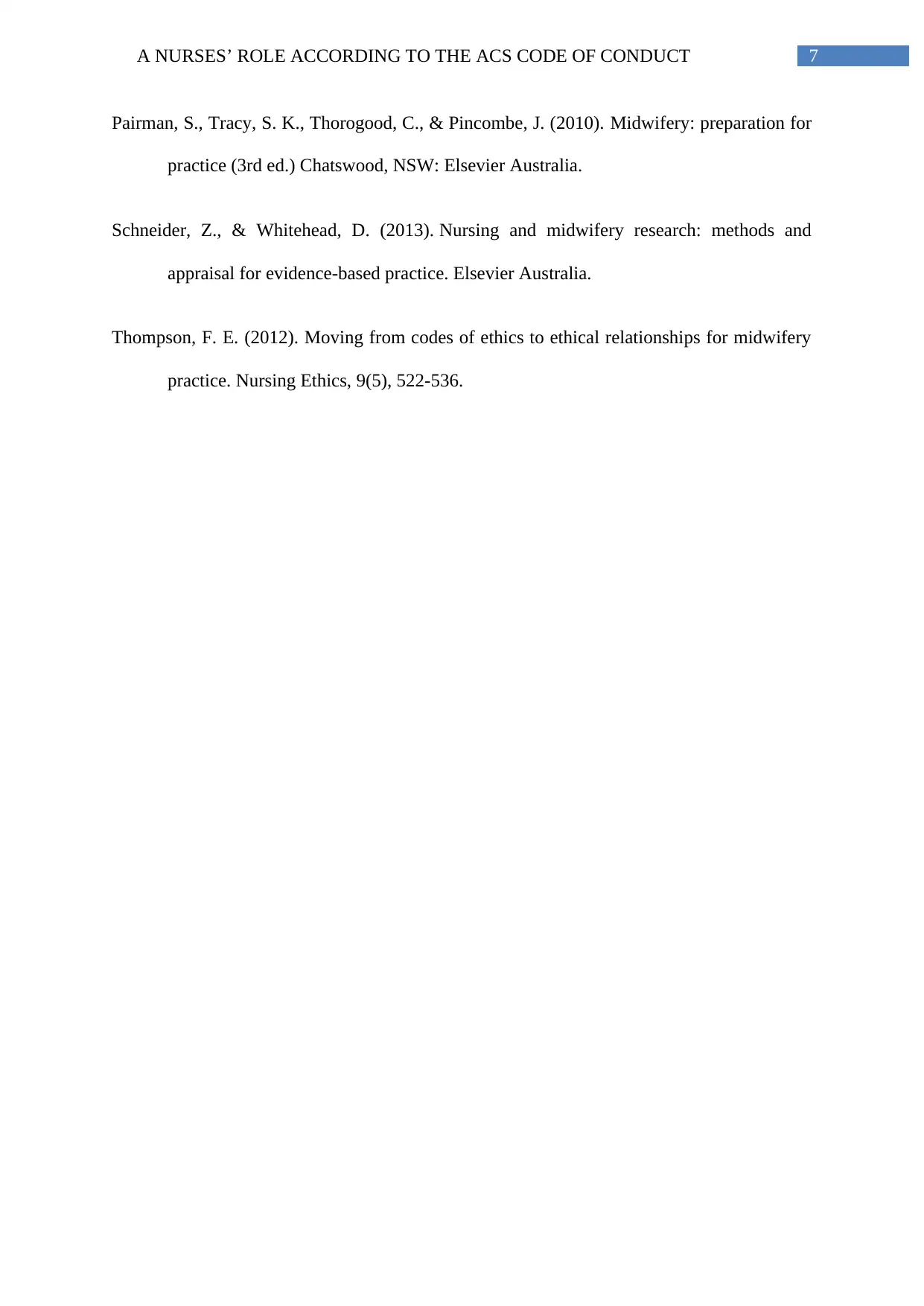
7A NURSES’ ROLE ACCORDING TO THE ACS CODE OF CONDUCT
Pairman, S., Tracy, S. K., Thorogood, C., & Pincombe, J. (2010). Midwifery: preparation for
practice (3rd ed.) Chatswood, NSW: Elsevier Australia.
Schneider, Z., & Whitehead, D. (2013). Nursing and midwifery research: methods and
appraisal for evidence-based practice. Elsevier Australia.
Thompson, F. E. (2012). Moving from codes of ethics to ethical relationships for midwifery
practice. Nursing Ethics, 9(5), 522-536.
Pairman, S., Tracy, S. K., Thorogood, C., & Pincombe, J. (2010). Midwifery: preparation for
practice (3rd ed.) Chatswood, NSW: Elsevier Australia.
Schneider, Z., & Whitehead, D. (2013). Nursing and midwifery research: methods and
appraisal for evidence-based practice. Elsevier Australia.
Thompson, F. E. (2012). Moving from codes of ethics to ethical relationships for midwifery
practice. Nursing Ethics, 9(5), 522-536.
1 out of 8
Related Documents
Your All-in-One AI-Powered Toolkit for Academic Success.
+13062052269
info@desklib.com
Available 24*7 on WhatsApp / Email
![[object Object]](/_next/static/media/star-bottom.7253800d.svg)
Unlock your academic potential
Copyright © 2020–2025 A2Z Services. All Rights Reserved. Developed and managed by ZUCOL.





